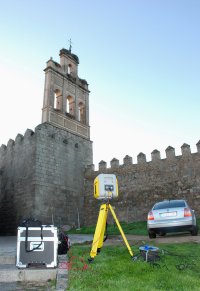Dec 14 2008
Researchers from the University of Salamanca used a terrestrial laser scanner (TLS) to evaluate the structural condition of the city walls of Avila. The system, used to aid maintenance of the structure, can detect collapse and movement within the stones.

The TLS, a laser measuring tool used to detect deterioration within architectural structures, was used by researchers from the University of Salamanca to assess the state of the city walls of Avila. The recently-invented system is used in monument maintenance work, above all on structures built centuries ago.
"The laser takes a very quick reading of the structure, from which we obtain a three-dimensional image," Diego Gonzalez Aguilera, co-author of the study published in the journal Nondestructive Testing and Evaluation, and an engineer at the University of Salamanca, told SINC.
The work began with data collection. This involved the researchers measuring the Avila walls in situ, specifically the belfry of the Puerta del Carmen gate, using a TLS. " This scanner emits a laser beam which bounces off the monument and returns to an internal sensor, measuring the distances between each point of the wall,” says the expert, adding that “the laser beam sweeps the entire surface of the monument".
The TLS takes two measurements, one of the inside part and the other of the outside of the walls, using 1.5 million and 2.5 million points, respectively. "These data are then analysed in the laboratory, where algorithms are used to create a 3D representation of the surface of both sides," says the researcher.
"One measurement alone is not enough to evaluate damage, however," adds Gonzalez Aguilera, "because each must be compared with previous or later samples." In this study, the researchers collected data at a six-month interval, because "the further apart in time the samples are taken, the greater the changes that can be observed", he explains.
This allows two types of architectural pathologies to be picked up: collapse, which is a wall's loss of verticality, and complete movement of the wall itself. The engineer points out that " the two sets of data and the amount of information collected must correlate in order for the results of the study to mesh together properly".
Other methods besides the TLS are used in to evaluate architectural structures. "The most classic is the theodolyte system to measure topography, although there are also other tools such as GPS," explains Aguilera. This study used the TLS because it is a new system that does not damage a structure and “it had to be tested in a complex situation”.